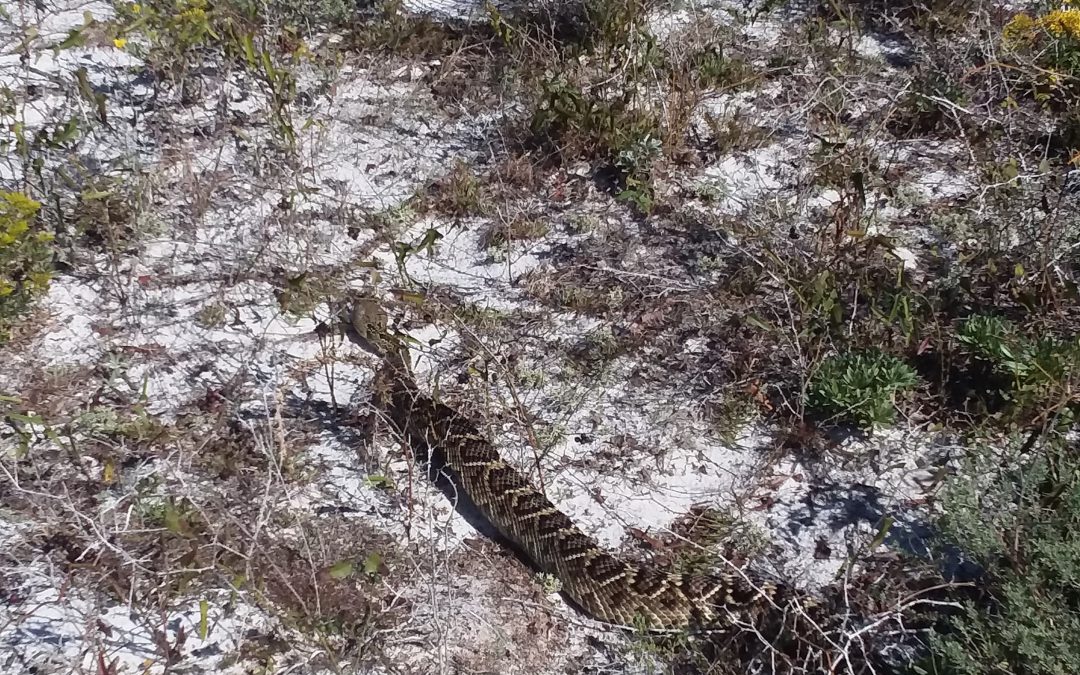
by Rick O'Connor | Dec 22, 2025
Though encounters with Eastern Diamondback Rattlesnakes are rare, bites from them are even more rare, and deaths from those bites almost nonexistent, it is worth discussing the issues and remedies of a bite.

The eastern diamondback rattlesnake is a classic serpent found in xeric habitats like barrier islands and deserts. They can be found in all habitats on barrier islands.
Photo: Bob Pitts
About 8000 people are bitten by snakes each year in the U.S. and Canada. Most are on the hands of men who were engaging the snake. 95% of those bitten are trying to either catch or kill them. Annually less than 12 people die from some species of rattlesnake bite. Many are young or old, with a suppressed immune system or pre-existing medical condition. Many who die, for whatever reason, refused medical treatment.
Most lethal bites are those that reach the heart or brain. However most bites are on the extremities where tissue and nerve damage can occur, but death is less likely. One reason some may refuse medical treatment is cost. Antivenin treatments are expensive. Typical bites may require 4-6 vials and costs were between $1500-$3500/vial in 2010. Add to this the cost of hospital stays, and you can see how expensive it can be.
Another reason given as to why medical attention was not sought is the fact that many venomous snakes will give what is called a “dry bite”. As mentioned in earlier articles, snake venom is “expensive” for snakes to produce, and it is intended for prey – not predators. Rattlesnakes will often give what is called a “bluff bite” – striking with their head but not even opening their mouths. The injection of venom is a voluntary action by the snake, and they may choose to inject very little, if any, venom even if the fangs penetrate. It is believed that about 50% of the rattlesnakes are dry bites. That said, you should never gamble on whether you received venom or not, you should go to the hospital.
The venom itself is a cocktail of proteins, polypeptides, digestive enzymes, and other compounds. It is basically modified salvia – which already includes some digestive enzymes. Myotoxins are a large component of rattlesnake venom. Myotoxins attack muscle tissue, cause pain, discoloration, minor bleeding, and swelling. This can be accompanied by chills, sweats, dizziness, disorientation, tingling and numbness of mouth and tongue, metallic taste, vomiting, diarrhea, bloody stools, alternating blood pressure and heart rates, blurred vision, muscle spasms, and neurotoxins can paralyze diaphragm leading to asphyxiation.
To avoid envenomation problems wear closed-toed shoes when hiking in rattlesnake territory. Do not extend your hand into brushy/grassy areas – use your hiking stick instead. Watch stepping over, or sitting on, logs and stumps without close surveying. Do not touch dead rattlesnakes, if not dead long, they can still bite. Carry a cell phone.
What to do if bitten…
Call 911.
Call poison control if you have their number.
Get to a hospital.
Remove rings, watches, etc. – swelling will occur.
Keep bite at, or below, heart level.
Remain calm.
What NOT to do if bitten…
Do not cut the wound.
Do not suck venom out.
Do not apply a tourniquet.
Do not apply ice.
Do not drink alcohol.
Do not use electroshock treatment.
Envenomation from an eastern diamondback rattlesnake is a scary thing. However, there are many ways to avoid this problem, and there is basic treatment if you are. Remember few people are bitten, and very few die. Get medical attention as soon as you can.
References
Rubio, M. 2010. Rattlesnakes of the United States and Canada. ECO Herpetological Publishing & Distribution. Rodeo, New Mexico. pp. 307.
Gibbons, W., Dorcas, M. 2005. Snakes of the Southeast. The University of Georgia Press. Athens, Georgia. pp. 253.
Graham, S.P. 2018. American Snakes. John’s Hopkins University Press. Baltimore, Maryland. pp. 293.
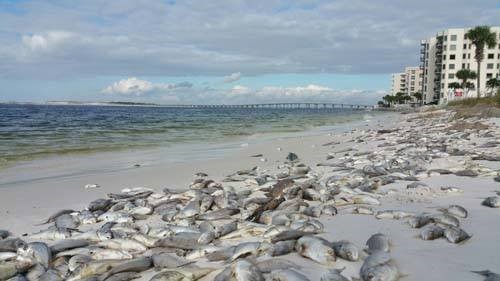
by Rick O'Connor | Dec 15, 2025
Almost everyone has heard of red tides and know they periodically occur off the coast of Florida. The more frequent events occur off southwest Florida between Tampa and the Keys, but they have occurred in other parts of the state.

Dead fish line the beaches of Panama City during a red tide event in the past.
Photo: Randy Robinson
When they do occur in the panhandle, they seem to be more common on the east side – Bay, Gulf, and Franklin counties. This year there has been a rather large red tide event that has lingered several weeks now in this area. There have been multiple samples that have been reported as HIGH (1,000,000 cells or more / liter). Cells in this case is referring to the organism that causes red tide – Karenia brevis.

The dinoflagellate Karenia brevis.
Photo: Smithsonian Marine Station-Ft. Pierce FL
K. brevis is a microscopic plant that belongs to the dinoflagellate group. They occur naturally in Florida waters and when conditions are good – will begin to multiple and create a bloom. These blooms can be large enough to discolor the water – often making it a rusty/reddish color… hence the red tide. Good conditions would be those you would think plants like – plenty of sunlight, warm temperatures, plenty of nutrients. When the wind is lower the water moves less allowing them to concentrate into large patches producing “the tide”. These small plants can release a toxin, known as brevotoxin. Brevotoxins are neurotoxins that affect the transmission of nerve signals, which can lead to several internal complications and possibly death for marine life.
Humans and animals typically ingest or inhale brevotoxins during a large red tide event. Fish kills are a common phenomenon during large events, but marine mammals and sea turtles have also been killed. During the recent red tide event in the St. Joe area fish kills have been reported, as well as respiratory problems with humans. We now also can include diamondback terrapins as a victim.
Terrapins are smaller brackish water turtles found along the coast of Florida. At the time of this article, scientists with the US Geological Survey had logged 66 dead terrapins from the St. Joe area, all were females, and most were large females.
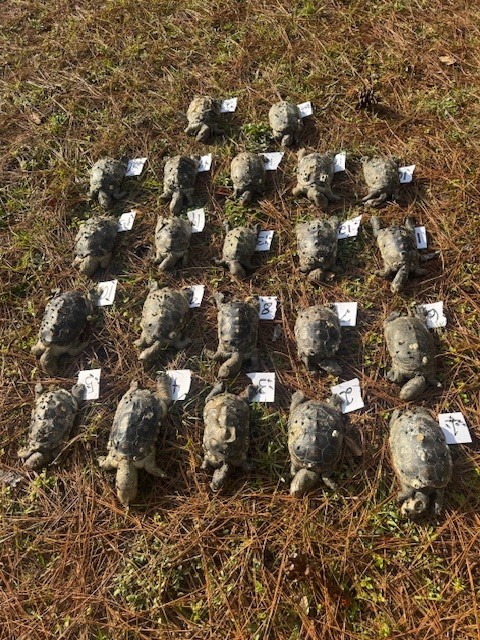
Diamondback terrapins lost during the recent red tide in St. Joe Bay.
Photo: Dan Catizone
At the time of this writing the tide in this area continues. High concentrations have been reported from Gulf, Bay, and Franklin counties. The most recent FWC report at the time of this article (December 5) red tide had been detected in 20 samples from the panhandle. Cell concentrations of >100,000/liter (medium-high) were reported from five of those. Background to medium concentrations were reported from Bay County. Background to low in Gulf and Franklin counties. Fish kills suspected to be related to the red tide occurred in Bay County but there were no reports of respiratory problems anywhere at that time.
Red tides seem to be more common in late summer and fall. NOAA believes the same climate pattern that has caused the drought, and no named tropical storms to hit Florida, may be the cause of the current patterns holding the red tide near the St. Joe area. Concentrations SEEM to be declining. Hopefully this one will not last much longer.

by Rick O'Connor | Dec 15, 2025
As many of you know, Escambia County Extension logs snakes people encounter when out and about during their day. We do not send people out to look for them but rather log those that people encounter when doing their normal activity. The objective of this project is to educate the public about which snakes people typically encounter, when they encounter them, and where.
The number of reports was down in 2025. We are not sure whether this was due to fewer people reporting, or whether there were fewer snakes encountered. Some who regularly report have told me they have not seen as many snakes this year. If this is the case it could be due to the snow event we had in the winter, the intense heat of this past summer, and the drought we have witnessed this summer/fall. We are not sure.
Of the 40 known species that inhabit the Pensacola Bay area – 19 were encountered this year. This compares to other years as follows –
| Year |
No. of Species Encountered |
| 2022 |
21 |
| 2023 |
24 |
| 2024 |
21 |
| 2025 |
19 |
Based on this people typically encounter about 50% of the species that live here. This year we were slightly below that at 47%.
Broken down by size classes we have the following for 2025…
| Size class |
No. of species known |
No. of species encountered |
Most common |
| Small (<12”) |
7 |
3 |
Florida Red-bellied Pine woods snake |
| Medium (12-24”) |
8 |
5 |
Eastern ribbon snake |
| Large (>24”) |
7 |
5 |
Southern black racer |
| Water Snakes |
13 |
2 |
Banded water snake |
| Venomous |
4 |
3 |
Cottonmouth |
| Non-native |
1 |
1 |
Brahminy blind snake |
| TOTAL |
40 |
19 |
Ribbon snake Southern black racer |
Small Snakes
First, small snakes are small; thus, more difficult to see. Most are encountered in gardens and landscaping. They are mostly nocturnal. This year the most common were both the Florida red-bellied snake and the Pine woods snake (both had 3 encounters). When compared to previous years…
| Year |
Most common small snake encountered |
| 2022 |
Southern ring-necked snake (3) |
| 2023 |
Rough earth snake (2) |
| 2024 |
Southern ring-necked snake (5) |
| 2025 |
Pine woods snake, Florida red-bellied snake (3) |
Medium Snakes
Some species in this group are the most frequently encountered snakes by residents. Like small snakes, most are encountered in gardens and landscaping. This year the Eastern ribbon snake. Not only was it the most encountered medium sized snake, but it also tied for the most common snake encountered all year. As you can see from the numbers below, this snake was encountered more frequently this year than others in the past.
| Year |
Most common medium snake encountered |
| 2022 |
Eastern ribbon snake (13) |
| 2023 |
Eastern garter snake (17) |
| 2024 |
Eastern garter snake (15) |
| 2025 |
Eastern ribbon snake (23) |
Large Snakes
There are 7 species of large snakes in the bay area and between 5-6 are encountered every year. Most likely this is because they are large, and easier to see. This year, like most years, the most encountered species is the Southern black racer. This snake does not mind humans and is often found in our neighborhoods and common in public areas as well. As you can see below, this is by far the most commonly encountered large snake and is one of the top three most common snakes encountered each year. This is a very common snake.
| Year |
Most common large snake encountered |
| 2022 |
Southern black racer (21) |
| 2023 |
Southern black racer (35) |
| 2024 |
Southern black racer (28) |
| 2025 |
Southern black racer (23) |
Water Snakes
There are more species of water snakes (13) than any other group. But they are some of the most infrequent snakes encountered in our area. This is most likely because several species only inhabit wetland/riverine systems where few residents venture. Other than the banded water snake, most other encounters have been reported by fishermen fishing on our rivers. This year, as every year, the Banded water snake was the most frequently encountered water snake. This is one of the top three most frequently encountered snakes each year. This is a very common snake here.
| Year |
Most common water snake encountered |
| 2022 |
Banded water snake (3) |
| 2023 |
Banded water snake (26) |
| 2024 |
Banded water snake (22) |
| 2025 |
Banded water snake (18) |
Venomous Snakes
There are only six venomous snakes reported in all of Florida. That is six out of a possible 46-48 species/subspecies (depending on which guidebook you use). All six have been reported in the Florida panhandle. Two of them only in the Florida panhandle – and they are both rare here; those being the copperhead and the timber rattlesnake. So actually, only four of the six venomous snakes have a good chance of being encountered: those being the cottonmouth, eastern diamondback rattlesnake, pygmy rattlesnake, and the eastern coral snake. Each year at least three of these are encountered. In 2023 all four were. Though each species has been encountered, other than the cottonmouth, the others are not encountered frequently. Encounters with the eastern coral snakes are particularly rare. That is not to say they are not common here, they are just not encountered very often, and that is fine with most people. Like the previous years, the most frequently encountered venomous snake is the Cottonmouth. Not only is the most frequent venomous snake, but it is also one of the top three most frequently encountered snakes overall. Cottonmouths are quite common here. The reason we may encounter it more often is because of its love of water – and most of us live near some source of water. The rattlesnakes prefer high dry semi-opened woodlands away from people. Coral snakes like more dense wooded areas; and almost every encounter of this snake has been in the Gulf Breeze area. However, they are found throughout the bay area.
| Year |
Most common venomous snake encountered |
| 2022 |
Cottonmouth (15) |
| 2023 |
Cottonmouth (52) |
| 2024 |
Cottonmouth (38) |
| 2025 |
Cottonmouth (21) |
Non-native Snakes
There is only one reported non-native snake in the Pensacola Bay area; the Brahminy blind snake – also known as the “flowerpot snake”. This Asian snake is about the length and diameter of a toothpick. It is blue to gray in color, and the tiny black eyes are barely visible. It is, for the most part, blind, and does not seem to be invasive. Most who encounter this snake are gardening or working in landscaping. I have them in my yard, and they are pretty common. Most who first see it will confuse it with a worm, until you notice the scaled body – then you know you are not dealing with a worm.
| Year |
# of Brahminy blind snakes encountered |
| 2022 |
0 |
| 2023 |
5 |
| 2024 |
2 |
| 2025 |
2 |
Number of Encounters by Species by Year
| Species |
2022 |
2023 |
2024 |
2025 |
TOTAL |
| Rough earth snake |
|
2 |
2 |
|
4 |
| Smooth earth snake |
|
|
|
1 |
1 |
| Marsh brown snake |
|
|
|
|
|
| Florida red-bellied snake |
1 |
5 |
4 |
3 |
13 |
| Southeastern crowned snake |
|
1 |
1 |
|
2 |
| Pine woods snake |
2 |
2 |
|
3 |
7 |
| Southern ring-necked snake |
3 |
5 |
1 |
|
9 |
| Scarlet snake |
|
3 |
1 |
1 |
5 |
| Rough green snake |
1 |
1 |
3 |
2 |
7 |
| Eastern ribbon snake |
13 |
10 |
9 |
23 |
55 |
| Eastern garter snake |
3 |
17 |
15 |
5 |
40 |
| Eastern hognose |
1 |
2 |
|
1 |
4 |
| Southern hognose snake |
|
|
|
|
|
| Mole kingsnake |
|
|
|
|
|
| Scarlet kingsnake |
|
|
1 |
|
1 |
| Eastern kingsnake |
1 |
1 |
2 |
2 |
6 |
| Florida pine snake |
|
2 |
|
|
2 |
| Gray rat snake |
3 |
9 |
11 |
7 |
30 |
| Corn snake |
3 |
7 |
5 |
6 |
21 |
| Southern black racer |
21 |
35 |
28 |
23 |
107 |
| Eastern coachwhip |
5 |
12 |
17 |
4 |
38 |
| Eastern indigo snake |
|
|
|
|
|
| Black swamp snake |
1 |
|
|
|
1 |
| Glossy crayfish snake |
1 |
|
|
|
1 |
| Queen snake |
|
|
|
|
|
| Midland water snake |
1 |
|
|
|
1 |
| Banded water snake |
3 |
26 |
22 |
18 |
69 |
| Gulf salt marsh snake |
|
3 |
2 |
|
5 |
| Yellow bellied water snake |
|
|
|
|
|
| Diamondback water snake |
|
|
|
1 |
1 |
| Brown water snake |
2 |
4 |
|
|
6 |
| Eastern green water snake |
|
3 |
1 |
|
4 |
| Western green water snake |
1 |
|
|
|
1 |
| Eastern/Western mud snake |
|
|
|
|
|
| Rainbow snake |
|
|
|
|
|
| Copperhead |
|
|
|
|
|
| Cottonmouth |
15 |
52 |
38 |
21 |
126 |
| Timber rattlesnake |
|
|
|
|
|
| Eastern diamondback rattlesnake |
5 |
8 |
11 |
8 |
32 |
| Pygmy rattlesnake |
5 |
6 |
1 |
|
12 |
| Eastern coral snake |
|
1 |
|
2 |
3 |
| Brahminy blind snake |
|
5 |
1 |
2 |
8 |
| TOTAL |
91 |
222 |
176 |
133 |
622 |
Discussion
The first statement is that 30 of the 40 known species found in the area have been encountered at least once. That is 75%. Most are medium sized to large sized snakes. There are only two species that have been encountered 100+ times over the last four years; those are Cottonmouth (126) and the Southern black racer (107). These are followed by two snakes that have been encountered between 50-100 times; those are the Banded water snake (69) and Eastern ribbon snake (55).
Those encountered between 25-50 times include:
Eastern garter snake (40)
Eastern coachwhip (38)
Eastern diamondback rattlesnake (32)
Gray rat snake (30)
Those encountered between 10-25 times include:
Corn snake (20)
Florida red-bellied snake (13)
Pygmy rattlesnake (12)
Those encountered between 2-10 times include:
Southern ring-necked snake (9)
Brahminy blind snake (8)
Pine woods snake (7)
Rough green snake (7)
Eastern kingsnake (6)
Brown water snake (6)
Gulf salt marsh snake (5)
Scarlet snake (5)
Rough earth snake (4)
Eastern hognose (4)
Eastern green water snake (4)
Eastern coral snake (3)
Southeastern crowned snake (2)
Florida pine snake (2)
Some of these species have populations of concern, and it is good they have been seen.
Those only seen ONCE in four years include:
Smooth earth snake (1) question identification – could have been rough earth snake
Scarlet kingsnake (1)
Black swamp snake (1)
Glossy crayfish snake (1)
Midland water snake (1)
Diamondback water snake (1)
Western green water snake (1)
Most of these are water snakes that live in habitats which few people visit. Others are smaller and harder to find.
AND THEN THOSE SPECIES THAT HAVE YET TO BE ENCOUNTERED IN FOUR YEARS.
Marsh brown snake
Southern hognose snake1
Mole kingsnake
Eastern indigo snake1
Queen water snake
Yellow bellied water snake
Eastern/Western mud snake
Rainbow snake2
Copperhead3
Timber rattlesnake3
1 species that are currently listed, or species of concern, and are rare in general.
2 species considered rare and under consideration of listing.
3 species that are common further north, but not as much in Florida.
We would like to thank all of you who have reported encounters in the Pensacola Bay area to myself. If you would like to participate, or have any questions, please contact me at Rick O’Connor – roc1@ufl.edu.
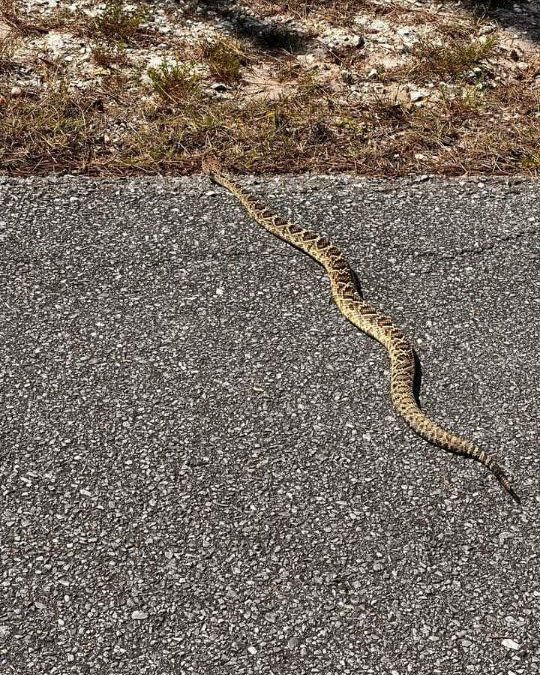
by Rick O'Connor | Dec 15, 2025
It is understood that rattlesnakes are carnivores and will select some form of meat for their food. The general principle is to select something that is easy to kill and requires less energy to do so. Most rattlesnakes will select rodents but depending on the species and the part of the world they are in, some will select lizards or other prey.
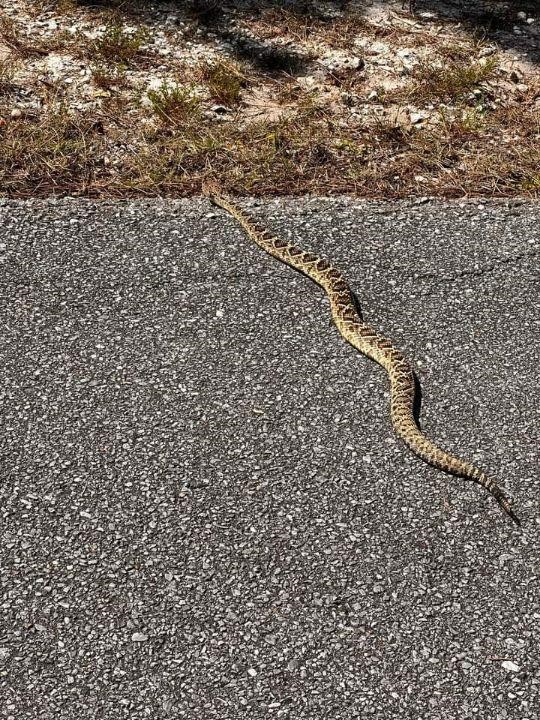
Eastern Diamondback Rattlesnake.
Photo: Bob Pitts.
Due to their long periods of hibernation and/or aestivation, their feeding seasons are shortened. If you add low prey availability when they emerge from hiding, the feeding season is shorter still. They respond by binge eating – basically gorging on prey as often as they can. They may consume massive meals that will take over a week to digest.
Rattlesnakes who feed on rodents over lizards will grow larger. Many species have young with bright pink or yellow tips on their tails, much like cottonmouths and copperheads. These are used to lure small prey such as lizards and toads. They are predominantly ambush hunters, lying in wait for selected prey to wander into striking range. They like spots where they are half in the shade, half in the sun to do this.
Here is a scenario…
In the spring, when the temperature reaches 70°F, rattlesnakes will leave the hibernacula they used for hibernation. Having not eaten in a while, food is on their mind. They will use their sense of smell to find the trails of their potential prey, find a good ambush spot, and wait. Some studies suggest they sleep while waiting. They may first detect their prey by seeing it. It could be by hearing or smelling. Or by a combination of these. They will begin to flick their tongues – using the Jacobsen’s organ – to further identify the target. When within range, the facial pits can help “see” the target and assist in accuracy of their strike.
The strike is extremely fast. The snake injects their venom, releases, re-coils, and folds their fangs back into their sheath. The target often will run but is usually dead within a minute and not far away. The rattlesnake will now find the scent trail with their tongue and follow its meal. It can take several minutes to an hour to find it. Once found the prey is dead and already in the process of digestion due to some of the enzymes within their venom. In some prey the rattlesnake may not release and rather hold on to the prey after the bite. This often happens when they select birds, possibly due to the difficulty of finding them because they may fly before they die. Another interesting twist to this scenario holds for the timber rattlesnakes, who sometimes lie at the base of a tree with their heads facing up the trunk waiting on an unaware squirrel coming down.
Swallowing the prey involves “unhinging” their lower jaw making the diameter of their mouths larger. This way rattlesnakes can swallow large prey such as squirrels and rabbits. They have six rows of smaller pointed teeth in their mouths. There are two rows on the lower jaw, two on the upper, and two on the roof of their mouths. With the fangs folded back in their sheath, they begin to grab the prey with one set of jaws (the right or left) pull in, then alternate with the other jaw. It appears they are “walking the prey down” their throat. There is a tube called the glottis on the forward portion of the lower mouth that is used for breathing while their mouth is full. They have been seen taking breaks and resting while this process is ongoing. After swallowing, they re-align their lower jaw and find a place to rest and digest the meal.
Being ectothermic they will need to find warmth to digest their meal. They require internal temperatures between 80-85°F for proper digestion, so, they will need to find a location where there is good sunlight but enough cover to hide them. Depending on the size of the meal, digestion can last up to a week.
This scenario can be altered if prey density is low. If it is, rattlesnakes may move, and forage more than they typically do. As you can see, an approaching human during any part of this scenario would be unwanted by the snake.
In the next article we will take a closer look at the venom of these snakes.
References
Rubio, M. 2010. Rattlesnakes of the United States and Canada. ECO Herpetological Publishing & Distribution. Rodeo, New Mexico. pp. 307.
Gibbons, W., Dorcas, M. 2005. Snakes of the Southeast. The University of Georgia Press. Athens, Georgia. pp. 253.
Graham, S.P. 2018. American Snakes. John’s Hopkins University Press. Baltimore, Maryland. pp. 293.
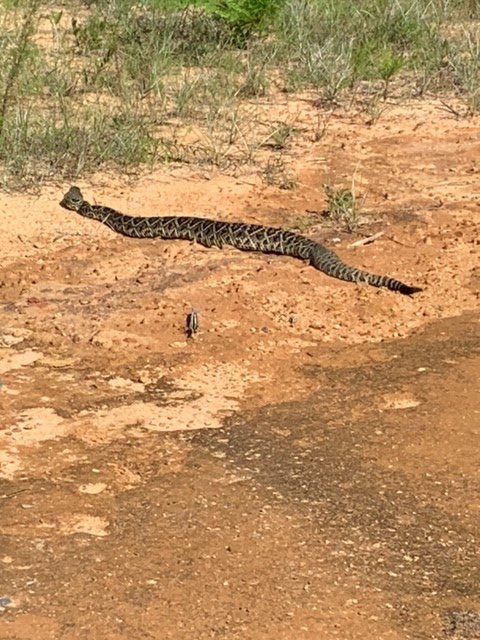
by Rick O'Connor | Dec 8, 2025
We will begin with a statement most know, but bears repeating… Snakes are just another animal trying to get through the day. They need to eat, avoid being eaten, find a place to sleep, and – at some point in the year – find a mate. They are no different than raccoons or hawks. But our reactions to these animals are very different to our reaction to raccoons and hawks. When hiking in the woods when someone says “bald eagle” the reaction is uplifting, maybe get a photo. But if someone says “snake” the reaction is different. If they say “rattlesnake” that reaction increases several magnitudes. In Manny Rubio’s book on rattlesnakes, he mentions that 50% of our population is “uneasy” about them and 20% are terrified of them – ophidiophobia is a real thing. That said, rattlesnakes are part of the barrier island ecology, and it is good to learn more about them.

This eastern diamondback rattlesnake was seen crossing a dirt road near DeFuniak Springs shortly after the humidity dropped.
Photo: Lauren McNally
Rattlesnakes are only found in the new world. There are 30 species listed in the U.S. and Canada and three of those live in Florida. One of them, the eastern diamondback rattlesnake, lives on our barrier islands. The pygmy rattlesnake may as well, but I have not encountered it (nor have heard of others encountering). The canebrake/timber rattlesnake is not common in Florida, and I have never heard of them on our islands.
These snakes differ from others in that they possess modified scales at the tip of their blunt tails we call rattles. Many snakes vibrate their tails when alarmed but this snake’s vibrations can be heard at a distance (up to 20-30 feet sometimes) to warn potential predators they are there. Each time the snake sheds its skin it will leave a new segment on the rattle. This is not a good way to age the snake however because they may shed several times in one year and older segments can break off. There have been reports of rattlesnakes with deformed tails and no rattles at all, but this is rare.
They also possess facial pits that have cells which can detect temperature radiating from an object, including “warm blooded” prey, while hiding. These thermal receptors lie along the bottom of the facial pit and are connected to the optic nerve; thus, they can sort of “see” heat.
Their eyesight is not as good as birds and mammals, and they have an elliptical pupil. They appear to use their eyesight in determining the size of the approaching animal and thus, their reaction to it.
They have nostrils but smell does not seem to play as important a role as Jacobsen’s organ does. This organ is found on the roof of their mouths. Rattlesnakes (all snakes) will flick their forked tongues to collect air molecules and stick the tip of each fork into a groove in the roof of their mouths that lead to this organ. Here they can taste/smell what is within their environment. The “taste” of potential prey will increase the frequency of tongue flicks and could cause the snake to move forward.
The fangs are the part of this animal we are most concerned about. They are hollow tubes connected to a venom gland which are located behind each jaw and give the snake the triangular head shape they are known for. These fangs are folded in a sheath so that they can close their mouths. Whether only one or both fangs are extended during a bite is controlled by the snake. Fangs often break off but smaller new ones are ready to replace them when needed. They will replace these fangs every two months, one at a time.
The strike involves opening the mouth, extending the fangs 90°, opening the mouth 180°, thrusting forward, bite down, inject, recoil, re-fold fangs, and back into the attack position. There are “offensive” and “defensive” strikes. Venom is “expensive” for snakes to produce and is meant for killing prey. The amount injected (if any at all) is controlled by the snake. A “defense” strike is slightly elevated. The upward angle reduces thrust and penetration depth.
Other general characteristics of rattlesnakes includes a triangular shaped head, most have a dark “mask” over their eyes, scales protruding over the eyes, keeled scales giving them a dry/rough appearance, and the males have longer tails than the females.
In our next post we will look at rattlesnake predation.
References
Rubio, M. 2010. Rattlesnakes of the United States and Canada. ECO Herpetological Publishing & Distribution. Rodeo, New Mexico. pp. 307.
Gibbons, W., Dorcas, M. 2005. Snakes of the Southeast. The University of Georgia Press. Athens, Georgia. pp. 253.
Graham, S.P. 2018. American Snakes. John’s Hopkins University Press. Baltimore, Maryland. pp. 293.









